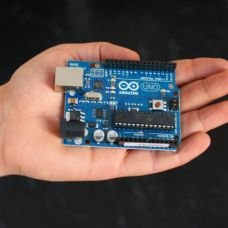Electronics For The Everyman: 25 Kick Ass Arduino-Powered Projects

Most of the projects listed include detailed hardware shopping lists, custom software and handy step-by-step instructions so that you can recreate them in your very own Fortress of Geeky Solitude. Unfortunately, that info is too long to recreate here, so be sure to hit the links provided with the pictures to visit the project pages and learn all the nitty gritty details for each project. And if all this microcontroller goodness piques your interest, Make Magazine’s blog and the Arduino section of the Instructables website are great resources for staying up to date with the latest and greatest Arduino news and projects. Now let’s get crackin’!
Let's start with something simple. For many people, the world runs on coffee. Automated timers are nice for having a fresh brewed pot when you wake up in the morning, but what if you're not quite sure when your next cup of joe will be needed? Enter Instructables' Tweet-A-Pot. This simple project lets you send a Tweet to your pot to get its coffee-brewing ass in gear remotely.
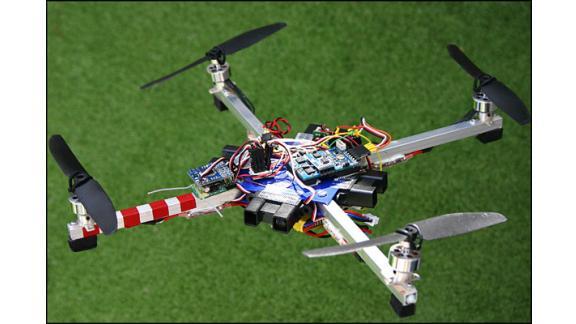
Jose Julio's ArduIMU Quadcopter III makes model flying idiot proof (Not that an idiot would be able to construct this bad boy, though). It uses sonar and IR distance sensors to hold position and altitude as well as navigate around obstacles. An experimental feature lets you program flight paths, too.

Here it is: the mind controlled Nerf gun. If you want to blast fools at the family BBQ using only your noggin' (and, um, a modified Nerf Stampede, an Arduino, and an expensive NeuroSky Mindset headband), Chris Meyer can show you how. Warning: this project isn't for rookies.

Now for something a little more useful than mind bullets: Simon72post's "Arduino Home Automation" project at Instructables allows him to control the heat, lighting and security system in his house over the Internet, even via smartphone or an altered remote control (pictured). Time-sensitive commands are also supported. It's not quite as polished as Z-Wave -- obviously -- but still pretty friggin' cool.
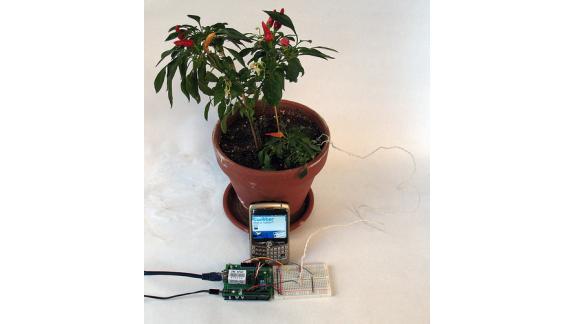
The Twitter DIY kit from Botanicalls monitors the moisture level in your houseplants. If your little green buddy needs watering, the plant sends you a Tweet to let you know it's thirsty. After you rehydrate it, the plant will send you another Tweet letting you know if you satiated it or if you suck at watering.

On the other hand, if you don't want to be bugged by your a plant's constant Tweets, Clover's "Plantduino Greenhouse" is "an automated watering and temperature system. This includes sensors that will turn the systems on only when needed." Lazy farmers swear by it!
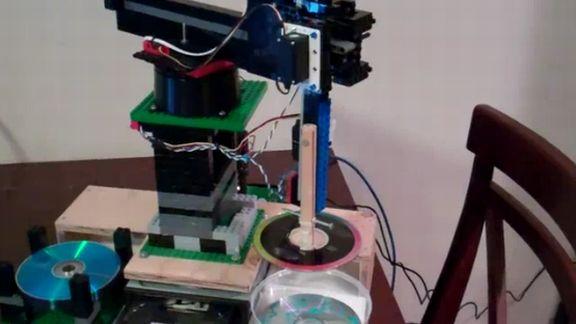
Paul Rea managed to combine a whole bunch of our geeky loves in his "CD Duplicator" project, which features an automated Lego arm that loads CDs or DVDs into a computer drive, rips the content, then deposits the spent media is a "Discard pile" There's a video of the build in action on Rea's project page.

Mirror mirror, on the wall, who's the fairest of them all? The DIY Magic Mirror doesn't pass superficial judgements like that, but it does offer up useful tidbits like weather forecasts and commentary on your stock portfolio's performance (in four different personas to boot). An optional breathalyzer sensor even allows the mirror to comment on your level of sobriety, and it can turn X10-controlled items on and off, too.

Ever wanted to host a game of Jeopardy from the comfort of your living room? The Quiz-O-Tron 3000 transforms Staples' "Easy" buttons into game show-style buzzers. Other users are locked out from buzzing in for five seconds once someone chimes in.

Who needs Guitar Hero when you can rock out with a DIY Arduino-powered air guitar? A left-hand glove changes the notes while a stick held in the right hand activates strumming. Check out the Airduino at Instructables.

The Spatialized Umbrella flashes LED lights and plays raindrop sound samples with increasing speed the closer you are to an object, thanks to built-in distance sensors. Navigating a dark room has never been easier (or cooler)! Our favorite part: it looks like it belongs in Blade Runner and actually works in the rain.

There are plenty of reverse geocaching Arduino projects out there -- boxes that only open at specific GPS coordinates -- but we like RickP's Fallout-like model, which uses nixie tubes, Ikea door handles and a caution tape-esque paint job to create a cool Cold War vibe.
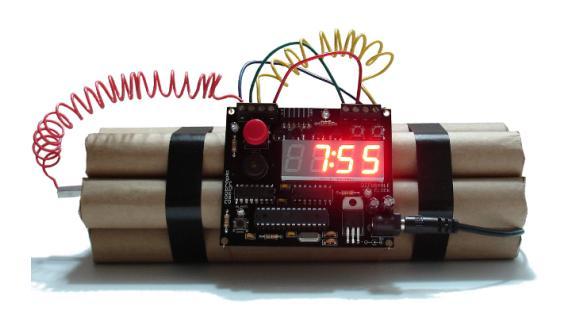
All right, the Defusable Clock technically uses an ATmega328 microcontroller, but it's cool, and hey, it uses the Arduino bootloader and IDE. Normally, it's just a clock, but pressing a big red button starts a countdown timer: you only have 10 seconds to cut the correct, randomly assigned wire! Choose wisely, Padawan.

This one's a bit more practical: an Instructables poster named Mkanoap rigged an Ethernet-enabled Arduino-powered stoplight to clearly display the xymon health status of critical servers in his workplace. Genius!

Who needs an Android plush doll from ThinkGeek when you can create your very own remote-controlled Android robot using a trash can and an Arduino? This link has videos of the 'bot in action and tons of in-process pics.

When is a harp cooler than a guitar? When it's a friggin' laser harp. According to creator Stephen Hobley, a wave of lasers expands out of the base unit, and users block the light to create MIDI synthesizer-created music. Sliding your hand up and down even changes the tone. Check it out.

Speaking of lasers, you could have the coolest haunted house on the block with this Arduino-powered laser maze. The creator hid his candy in the back of the garage and forced sweet tooth-bearing children to brave the maze to obtain it. Touching a laser makes an alarm sound and a police light to flash, and a point is added to your score. Check it out.

If you have trouble remembering to feed your cat, Google engineer Damon Kohler has the Arduino project for you: a cat feeder connected to a microcontroller and an HTC Magic smartphone. It dispenses food whenever you cat approaches or at a set schedule. Kohler earns bonus points for using his MakerBot to 3D print the brackets and food chute.

Based off of a nonlethal weapon created for the Department of Homeland Security, this Arduino-powered "Bedazzler" uses pulsing, flashing, multi-colored lights to induce "Nausea, dizziness, headache, flashblindness, eye pain and (occasional?) vomiting." You can whip one of your own together for just $250.

So you've created the Airduino and the Laser Harp -- but have you mastered them? The BBC's "Rockter Scale" project uses multiple sensors to rate your rocking abilities based on head thrashing, movement, crowd surges, and audio volume/frequency. Can you rock it all the way to 11 on the scale?

Casey Pugh created this awesome Daft Punk helmet out of "a 16x5 LED matrix installed inside a cheap motorcycle helmet I found on Amazon." An Arduino controls the changing lights. This Vimeo page has a video of him creating the Halloween masterpiece.

Who's up for a drink? iZac, the Android Bartender, whips up cocktails that users order via a Motorola Xoom tablet. There's even an "I'm feeling lucky" entry for surprise concoctions. "My apologies to the person who got 2/3 lemon juice, 1/3 campari - but the regular cocktails were generally agreed to be pretty good," creator Nick Johnson writes.

The Nintendo Keyless Entry System uses an old-school NES gamepad in lieu of a traditional numerical keypad. Users press the preprogrammed button code, then press "Select" and "Start" to enter it. If it's right, a CD tray opens and pushes open the door lock. If it's the wrong code, a failure noise is played and the system snaps a pic of the perp.

The Magic Crystal Mood Ball contains a temperature sensor that measures just how hot and bothered a user is, then turns the associated "Mood color," just like a normal mood ring. "If you are feeling comfortable and calm, the temperature of your skin is going to be normal (about 27 degrees Celsius or 82 degrees Fahrenheit), and the ball is Cyan," the creator writes.
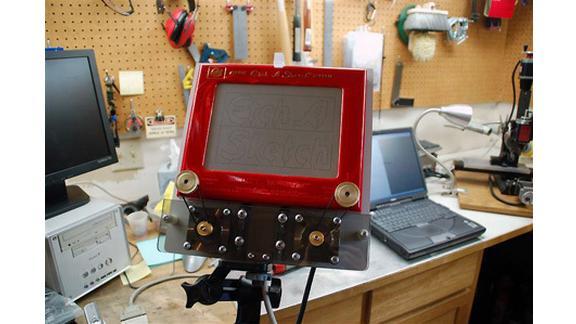
We've saved one of the best for last: the Etch-A-Sketch Clock. Every minute, the clock automatically flips itself over and erases itself, then sketches out the new time. Unfortunately, we couldn't find detailed build instructions, but you can watch a video of it in action here. Utterly pointless and utterly cool.
